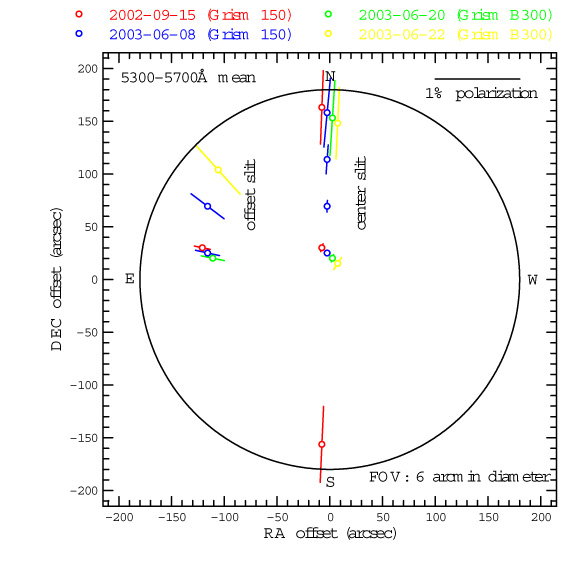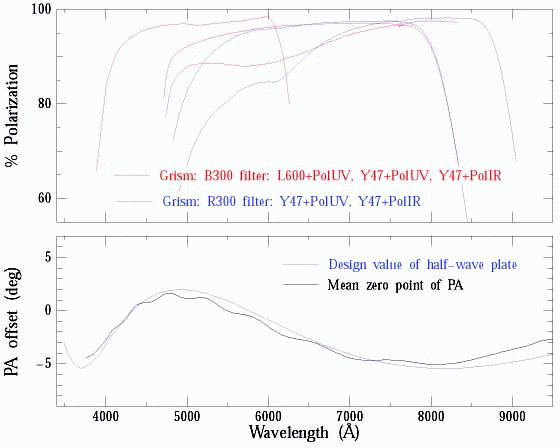Calibrations required for FOCAS polarimetry
Observers should take the following data for a full calibration of their polarimetric data. Not all data need to be taken for every object observed, although it is recommended that observers confirm those polarimetric properties of the instrument at least once in an observation run. Especially, the instrumental polarization should be checked at the same CCD position as the target.
1. Observation of polarimetric standard stars
Unpolarized standard star for linear polarimetry
FOCAS has an almost stable instrumental polarization of order p=0.05% at any position within field of view (FOV). However, the level of instrumental polarization highly depends on the position in FOV. Also, it is slightly wavelength-dependent. The degree of polarization, p_ins, and its position angle, PA_ins, are expressed as \( p_{\text{ins}} \sim 1.2 \times 10^{-9} r^4 \) (%) and \( \text{PA}_{\text{ins}} \sim \text{PA}_{\text{FOV}} \) at B, V and R-bands, where r is the radial distance from the center of FOV in arcsec and PA_CCD is the position angle of the position in FOV. The instrumental polarization pattern near V band is shown in Fig. 4. For the correction of it, you should obtain polarimetric data of unpolarized standard stars at the same slit position where you obtain those of your target(s) during your observation run. For imaging polarimetry of a diffuse object, you should take data of unpolarized stars at many positions in FOV and construct an instrumental polarization map at each band used for target observation.

Figure 4. Sample of instrumental polarization pattern
Strongly polarized standard star for linear polarimetry
To know the zero point of the position angle of polarization in the celestial plane, the observer should obtain data of strongly polarized standard stars.
Standard stars for circular polarimetry
Although the FOCAS members are not fully familiar with circular polarimetry, it is recognized that no standard star observation is necessary for circular polarimetry with 0.2-0.3 % accuracy. If you expect a circular polarimetry with higher precision, you are asked for arranging your own calibration method. We welcome any your comment.
Table 1. Commonly Used Standard Stars for FOCAS Linear Polarimetry
Strongly Polarized Standard Stars (*V*-band data)
| Star | RA2000 | DEC2000 | Mag. | Sp. | Pol. (%) | PA(deg) | Ref. | Comment |
|---|---|---|---|---|---|---|---|---|
| BD+64d106 | 00 57 36.7 | +64 51 27 | 10.3 | B1V | 5.69±0.04 | 96.6±0.2 | Sch92 | |
| HD 7927 | 01 20 04.9 | +58 13 54 | 5.0 | F0Ia | 3.32±0.04 | 92.1±0.2 | Wol96 | |
| BD+59d389 | 02 02 42.1 | +60 15 27 | 9.1 | F0Ib | 6.70±0.2 | 98.1±0.1 | Sch92 | |
| HD 19820 | 03 14 05.4 | +59 33 48 | 7.1 | O9IV | 4.82±0.03 | 115.4±0.3 | Wol96 | |
| HD 25443 | 04 06 08.1 | +62 06 07 | 6.8 | B0III | 5.15±0.03 | 135.1±0.2 | Wol96 | |
| HD 251204 | 06 05 05.7 | +23 23 39 | 10.3 | B0IV | 4.04±0.07 | 147.0 | Tur90 | |
| HD 43384 | 06 16 58.7 | +23 44 27 | 6.3 | B3Ib | 2.94±0.04 | 169.8±0.7 | Hsu82 | |
| HD 154445 | 17 05 32.2 | -00 53 32 | 5.6 | B1V | 3.67±0.05 | 88.6±0.7 | Wol96 | |
| HD 155197 | 17 10 15.6 | -04 50 03 | 9.2 | A0 | 4.38±0.03 | 103.2 | Tur90 | |
| HD 161056 | 17 43 47.0 | -07 04 46 | 6.3 | B1.5V | 4.00±0.01 | 66.3±0.3 | Wol96 | |
| Hiltner 960 | 20 23 28.4 | +39 20 56 | 10.6 | B0V | 5.66±0.02 | 54.8±0.1 | Sch92 | V~14 companion star at ~6" NW |
| VI Cyg #12 | 20 32 40.9 | +41 14 26 | 11.5 | B5Ia | 8.95±0.09 | 115.0±0.3 | Sch92 | |
| HD 204827 | 21 28 57.7 | +58 44 24 | 7.9 | B0V | 5.34±0.02 | 58.7±0.4 | Wol96 |
Strongly Polarized Standard Stars (*r'*-band data)
| Star | RA2000 | DEC2000 | Mag. | Sp. | Pol. (%) | PA(deg) | Ref. | Comment |
|---|---|---|---|---|---|---|---|---|
| SA110-229 | 18 40 45.66 | +00 01 49.8 | 12.89 | 2.408±0.029 | 19.2±0.3 | Blinov+ 2023 | ||
| SA110-233 | 18 40 52.71 | +00 00 50.8 | 12.31 | 2.620±0.033 | 12.0±0.4 | Blinov+ 2023 |
Unpolarized Standard Stars (*V*-band data, except for Tur90)
| Star | RA2000 | DEC2000 | Mag. | Sp. | Pol. (%) | PA(deg) | Ref. | Comment |
|---|---|---|---|---|---|---|---|---|
| Beta Cas | 00 09 10.7 | +59 08 59 | 2.3 | F2III | 0.04±0.02 | 72.5 | Sch92 | |
| HD 12021 | 01 57 56.1 | -02 05 58 | 8.9 | B7 | 0.08±0.02 | 160.1 | Sch92 | |
| HD 14069 | 02 16 45.2 | +07 41 11 | 9.0 | A0 | 0.02±0.02 | 156.6 | Sch92 | |
| HD 21447 | 03 30 00.2 | +55 27 07 | 5.1 | A1IV | 0.05±0.02 | 171.5 | Sch92 | |
| G191B2B | 05 05 30.6 | +52 49 54 | 11.8 | DA1 | 0.06±0.04 | 147.7 | Sch92 | |
| HD 94851 | 10 56 44.2 | -20 39 52 | 9.2 | B9 | 0.06±0.02(B) | --- | Tur90 | |
| GD 319 | 12 50 04.5 | +55 06 03 | 12.3 | DA | 0.09±0.09 | 140.2 | Sch90 | |
| Gamma Boo | 14 32 04.7 | +38 18 30 | 3.0 | A7III | 0.07±0.02 | 21.3 | Sch92 | |
| HD 154892 | 17 07 41.4 | +15 12 38 | 8.0 | F8V | 0.05±0.03(B) | --- | Tur90 | |
| BD+32d3739 | 20 12 02.1 | +32 47 44 | 9.3 | A6V | 0.03±0.02 | 35.8 | Sch92 | |
| BD+28D4211 | 21 51 11.1 | +28 51 52 | 10.5 | oP | 0.05±0.03 | 54.2 | Sch92 | V~15 companion star at ~4" N |
| HD 212311 | 22 21 58.6 | +56 31 53 | 8.1 | A0V | 0.03±0.02 | 51.0 | Sch92 | |
| Zeta Peg | 22 41 27.7 | +10 49 53 | 3.4 | B8III | 0.05±0.02 | 40.0 | Sch92 |
(*) Note that the comments for the presence of nearby companion star are not complete.
Unpolarized stars are also listed in Piirola et al. 2020. The most stars in table 6 are between 7.0 and 8.0 V mag, and located in between Decl. of 0 and +40 deg.
Unpolarized stars (white dwarfs in the northern hemisphere) are also listed in Zejmo et al. 2017. The stars are between 13 and 17 mag in r-band. The positions are in table 1, and polarimetric observations are in table 4.
NOT/ALFOSC page also lists strong and unpolarized standard stars.
References
- Hsu82: Hsu & Breger (1982; ApJ, 262, 732)
- Sch92: Schmidt, Elston, & Lupie, (1992; AJ, 104, 1563)
- Tur90: Turnshek, et al. (1990; AJ, 99, 1243)
- Wol96: Wolff, Nordsieck, & Nook (1996; AJ, 111, 856)
- Blinov+ 2023: Blinov et al. (2023; A&A, 677, A144)
2. Observation of dome flats through fully-polarizing filter
From an observation through fully-polarizing filter, we obtain (1) the wavelength dependence of the equivalent optical axis of the multi-layer half-wave plate, and (2) the depolarization factor of FOCAS. Although the latter (2) should be negligible (\(dP/P < 0.05\)) for most cases, the former (1) should be corrected. Although we will provide a correction table for (1), those who need higher accuracy and reliability should take dome flats with fully-polarizing filters. FOCAS has two such filters, one for the optical wavelength region and one for the near IR region.

Figure 5. Spectropolarimetry sample of dome-flat image taken through fully-polarizing filters.
3. Distortion
In the case of long-slit spectropolarimetry or imaging polarimetry for a diffuse (extended) object, the observer should know the distortion pattern in the 2D-spectral or field images. We will provide the distortion pattern table (ready to use for IRAF/geomap). Those who need higher accuracy for the distortion correction, they need to obtain the data with the special masks for the distortion measurement using arc lamps and/or dome flat lamps. If the object is point-like (i.e., the observer does not need to know the spatial information on the image), one does not have to obtain the distortion calibration image.
4. Arc lamp for wavelength calibration
This should be taken in the same manner as for non-polarimetric spectroscopy.
5. Normal dome flats for flatfield
These should be taken in the same manner as for non-polarimetric spectroscopy/imaging observations. However, you must obtain flat-field images at each wave plate position (i.e., PA=0.0, 45.0, 22.5, and 67.5 for linear polarimetry and PA=45.0 and 135.0 for circular polarimetry) for each FOCAS optics configuration to obtain flat-field image of synthetic un-polarized light (after combining the set of images).